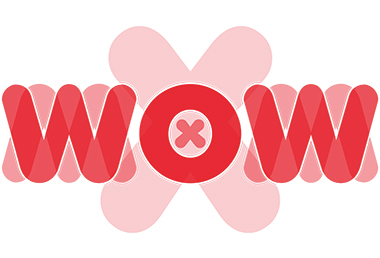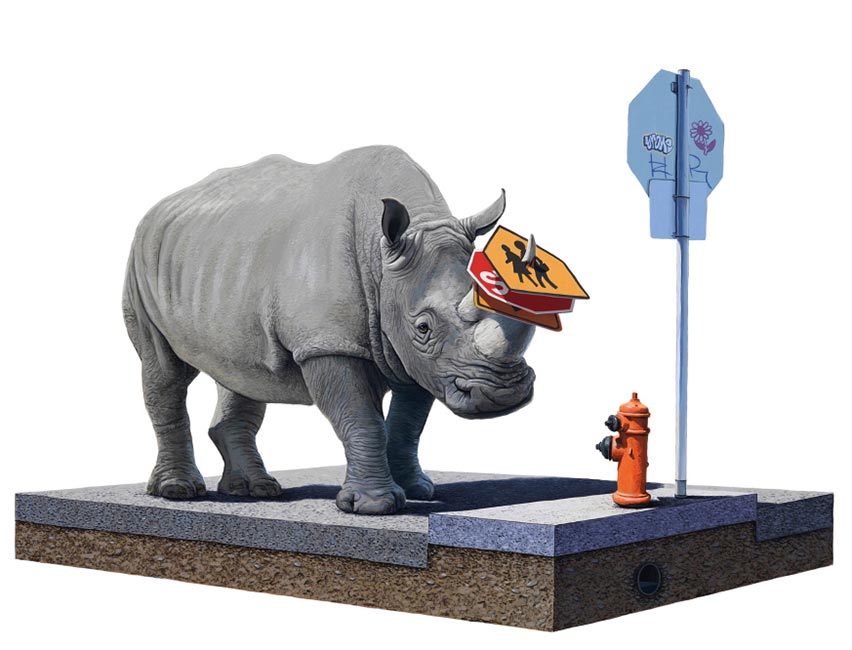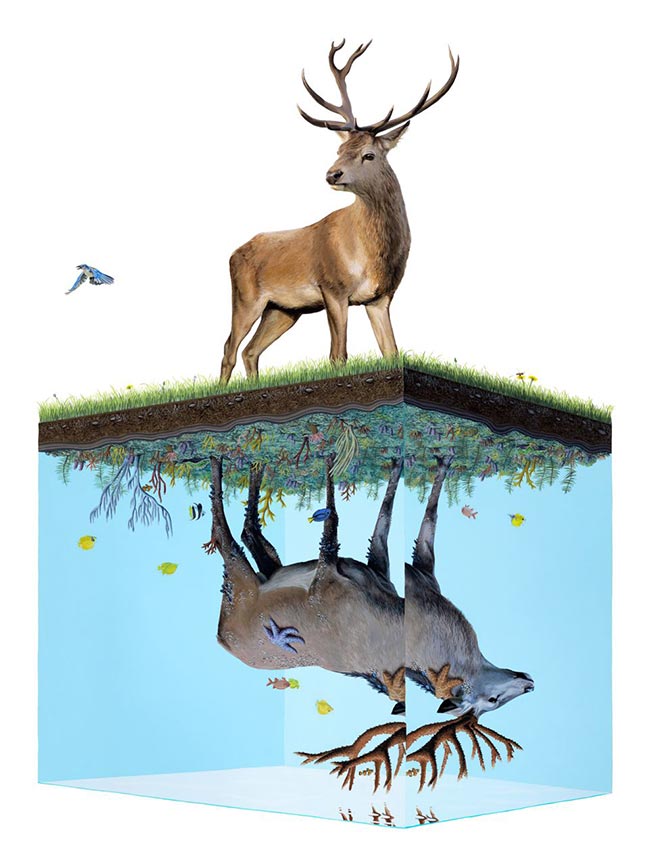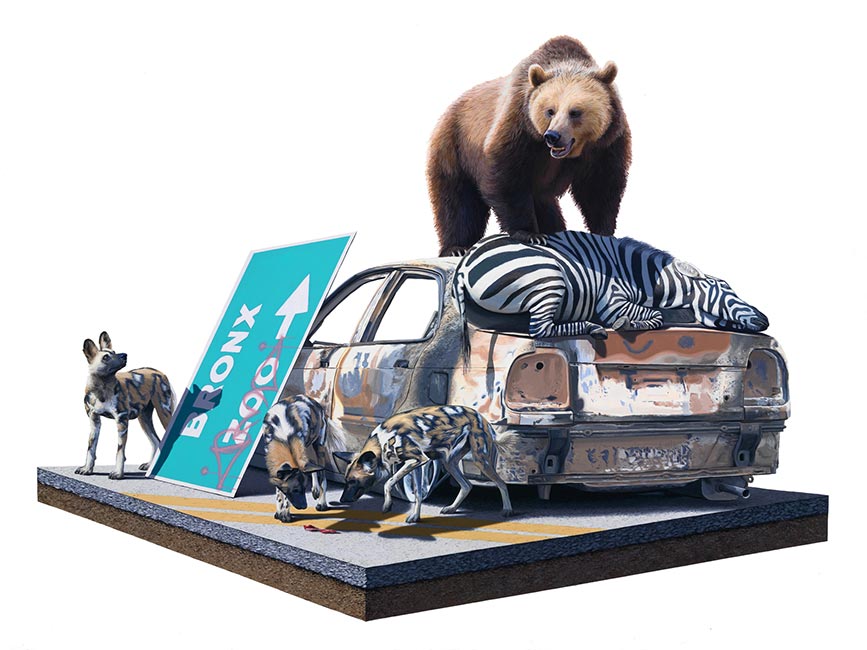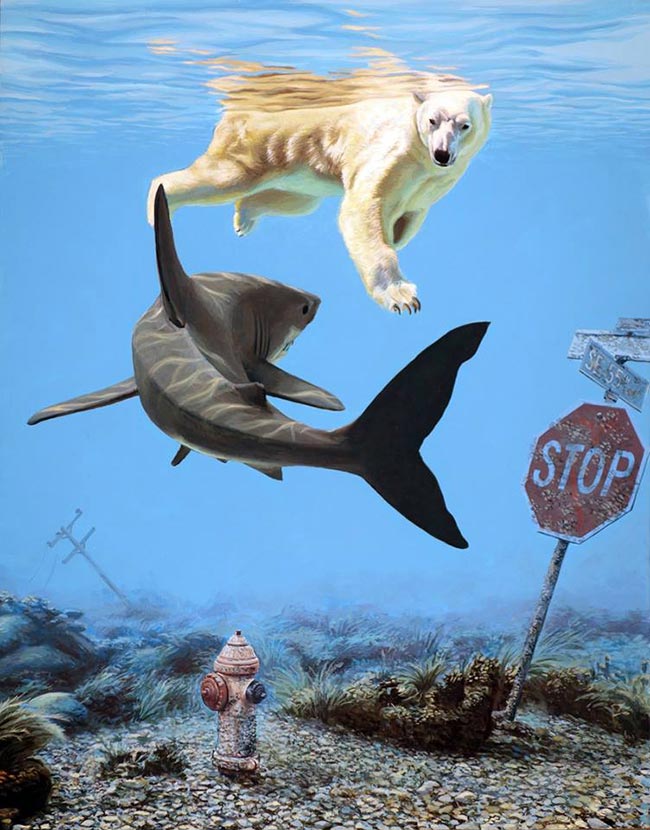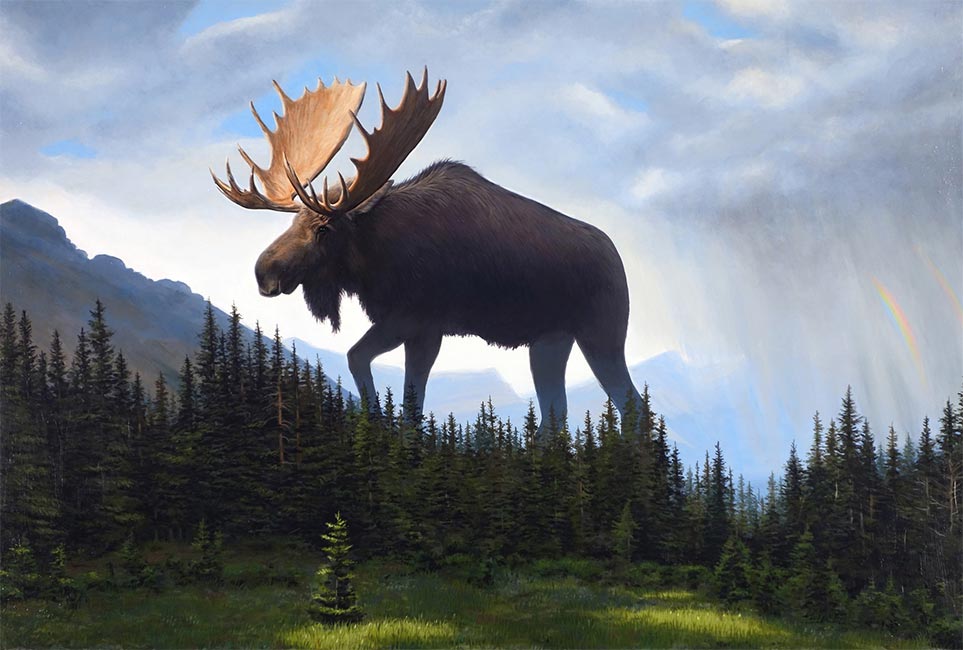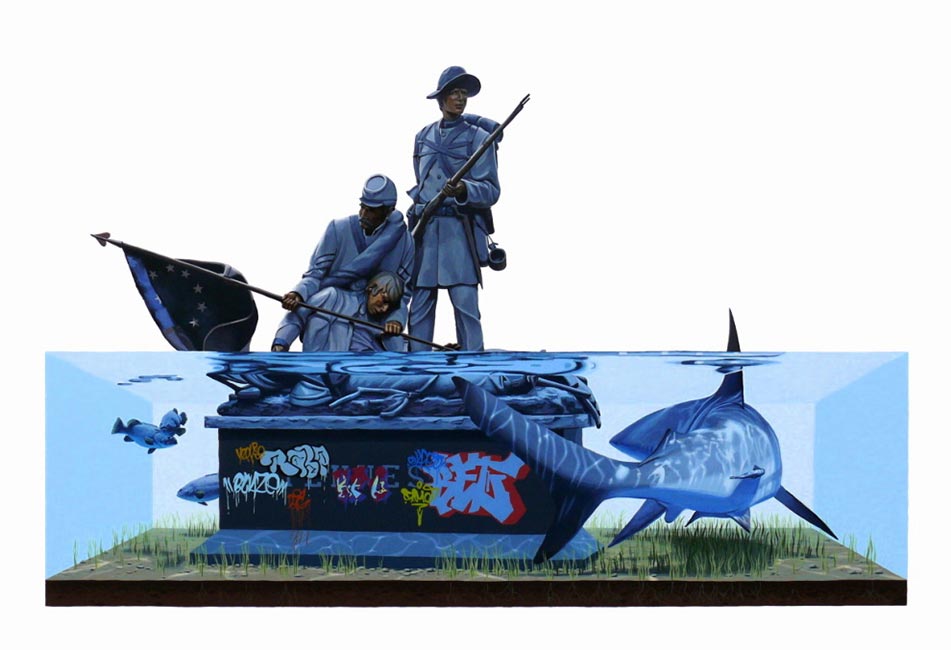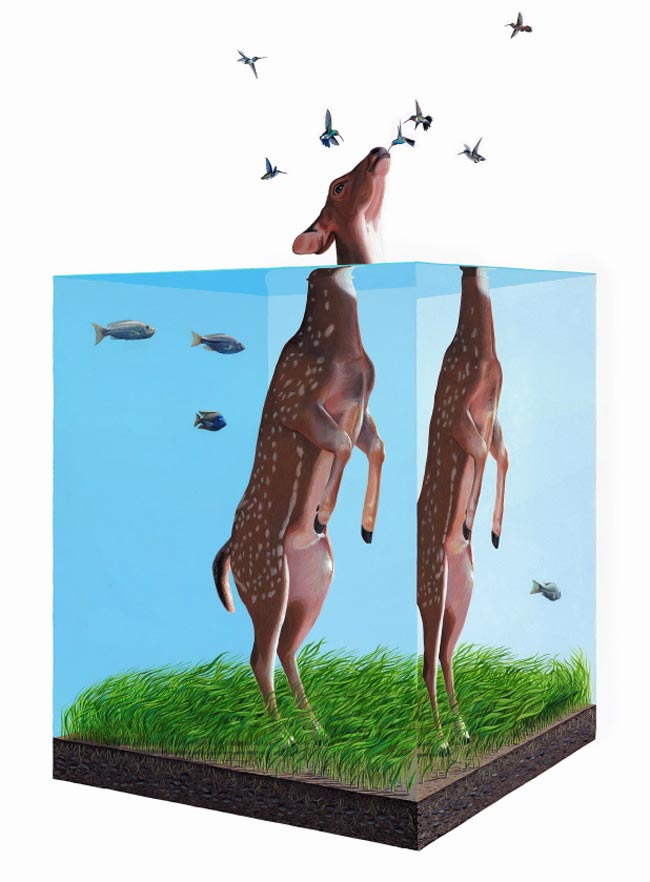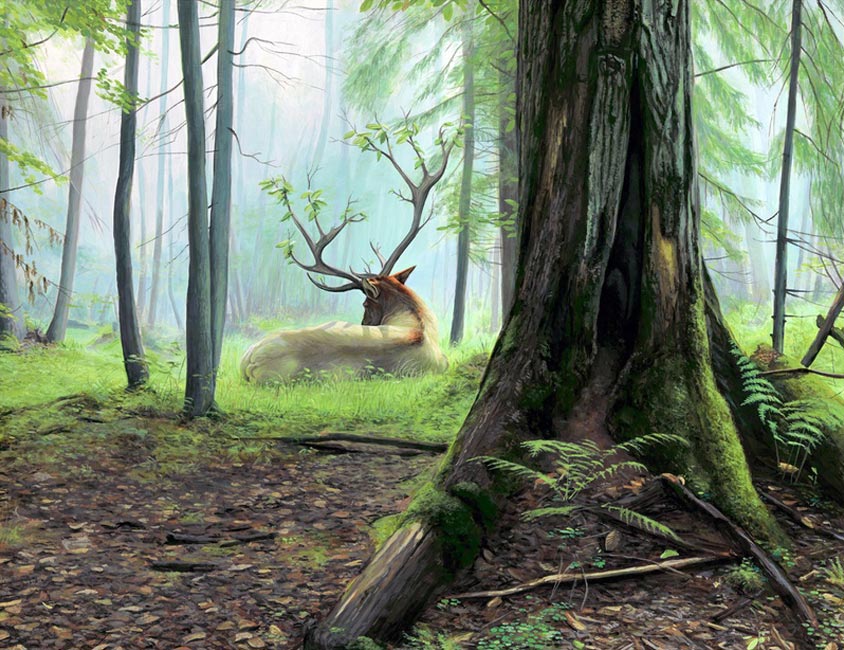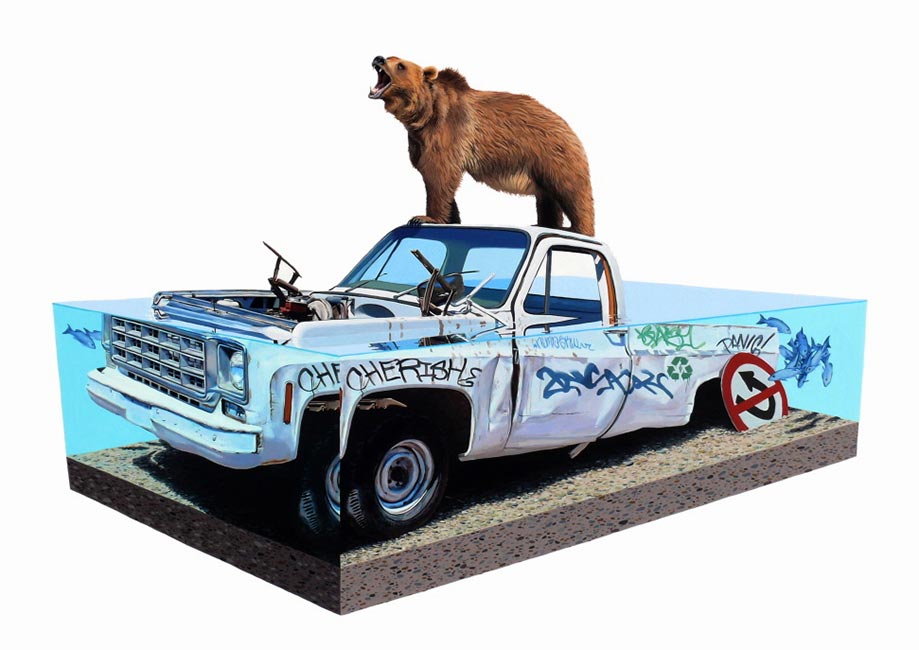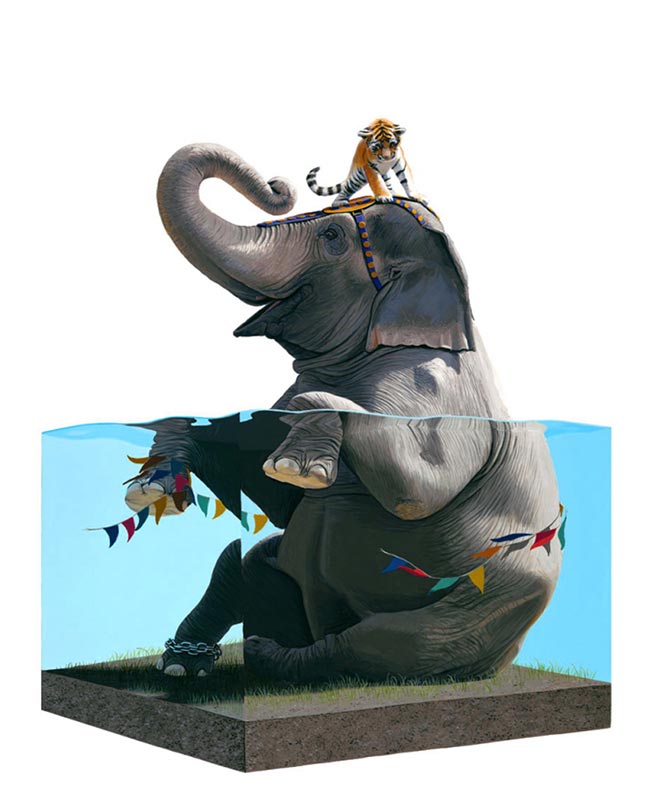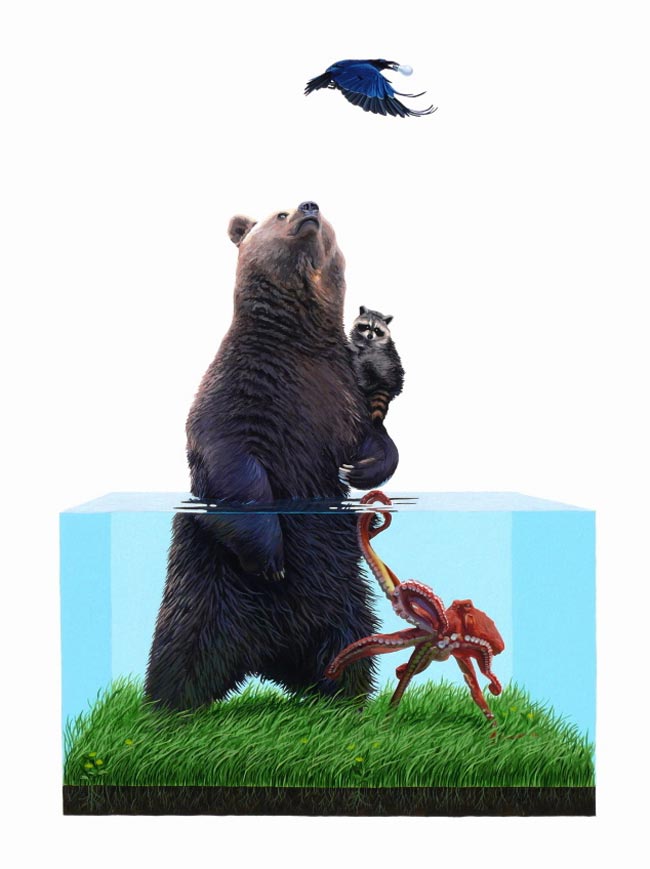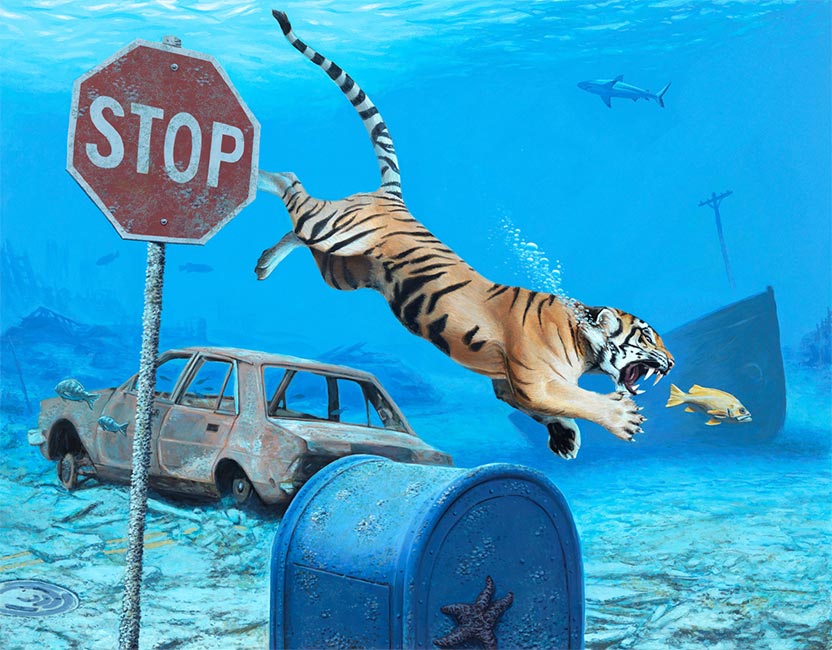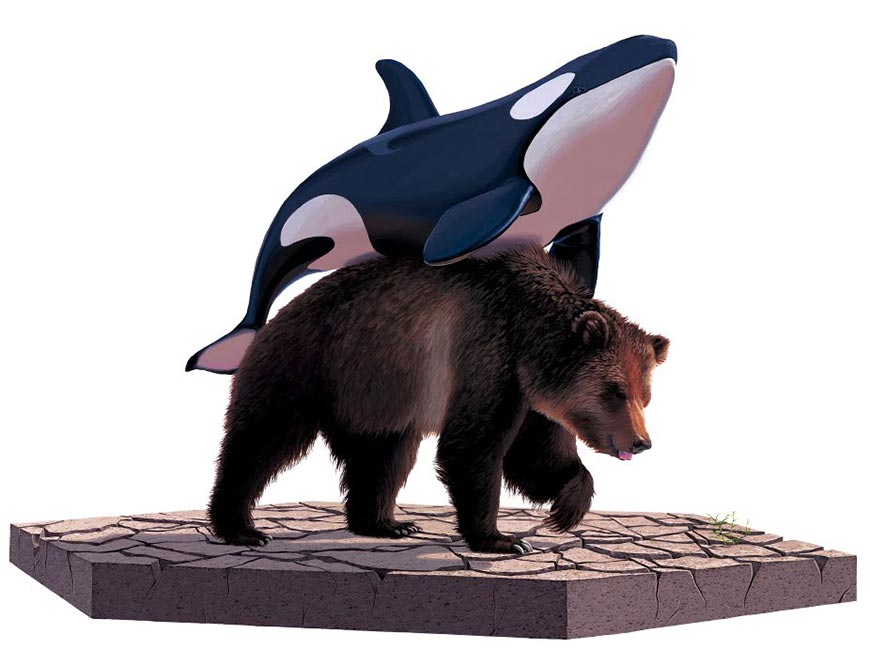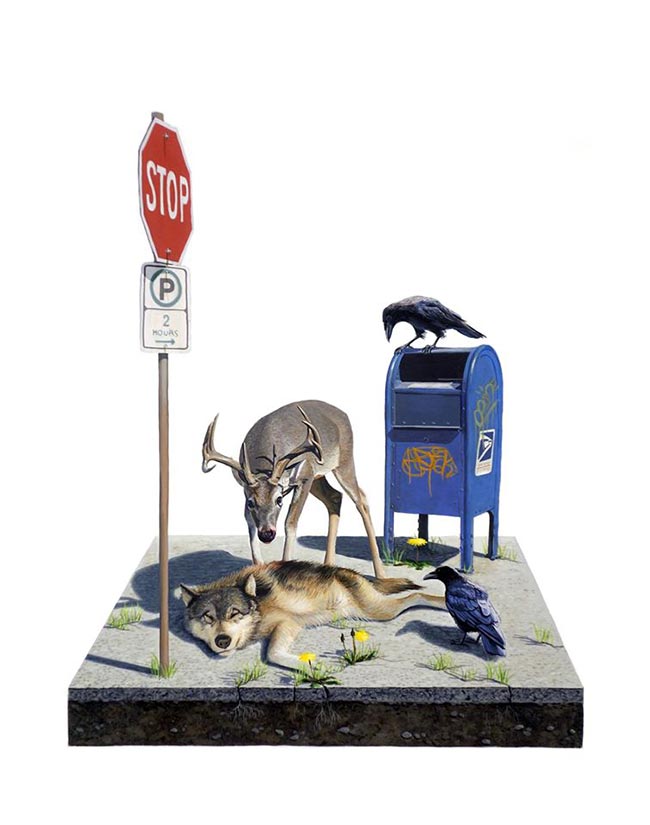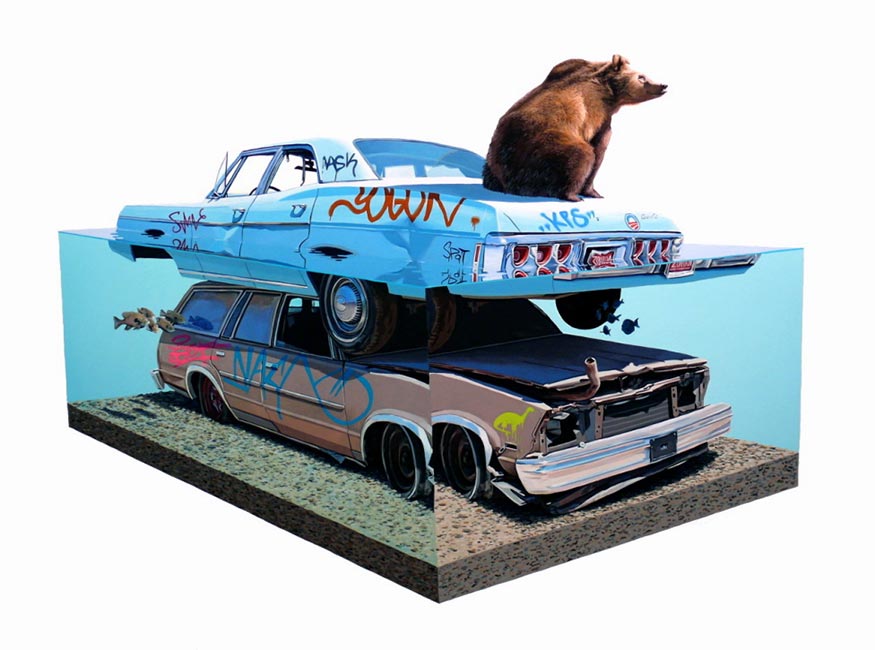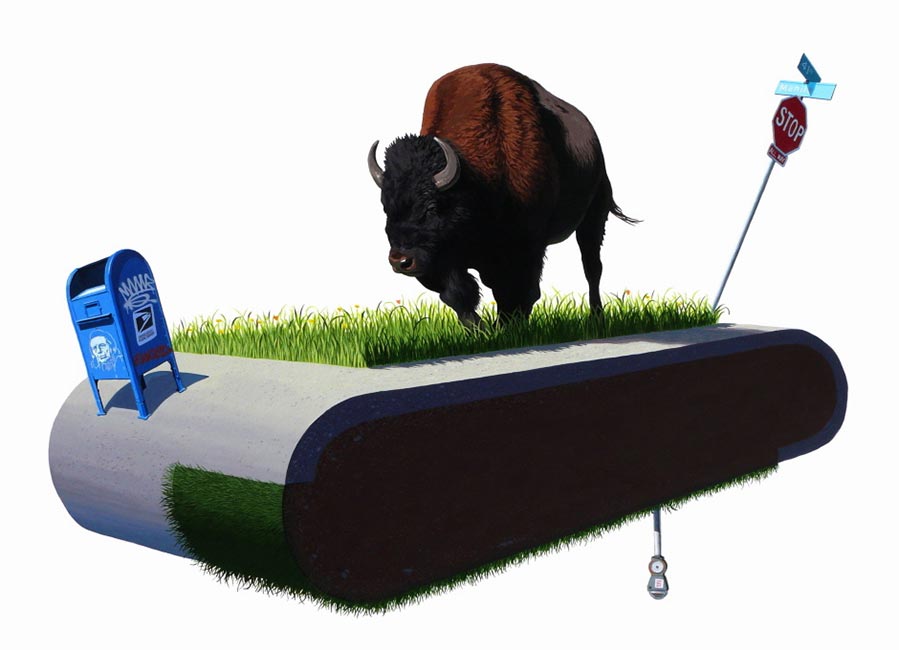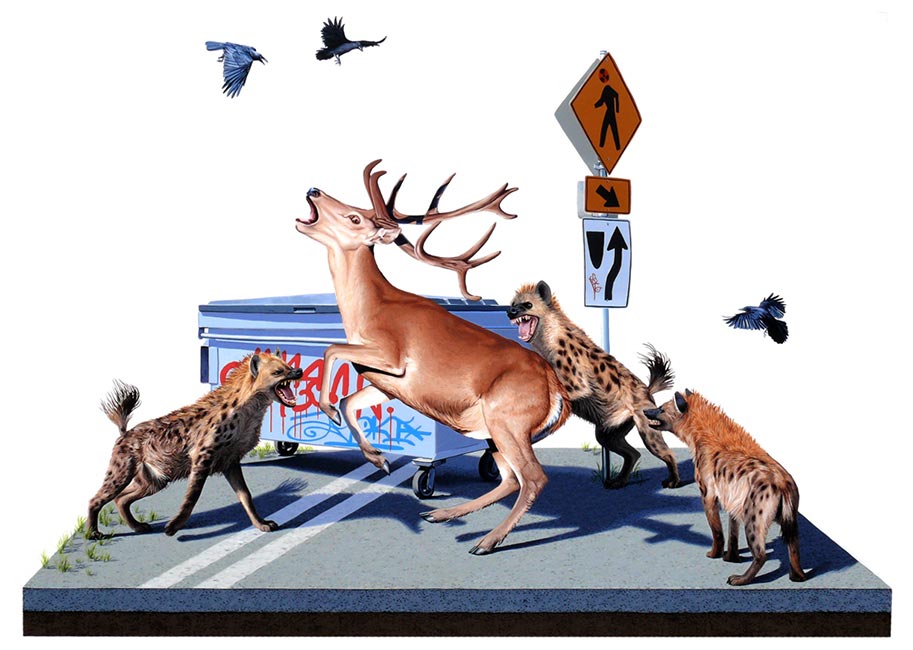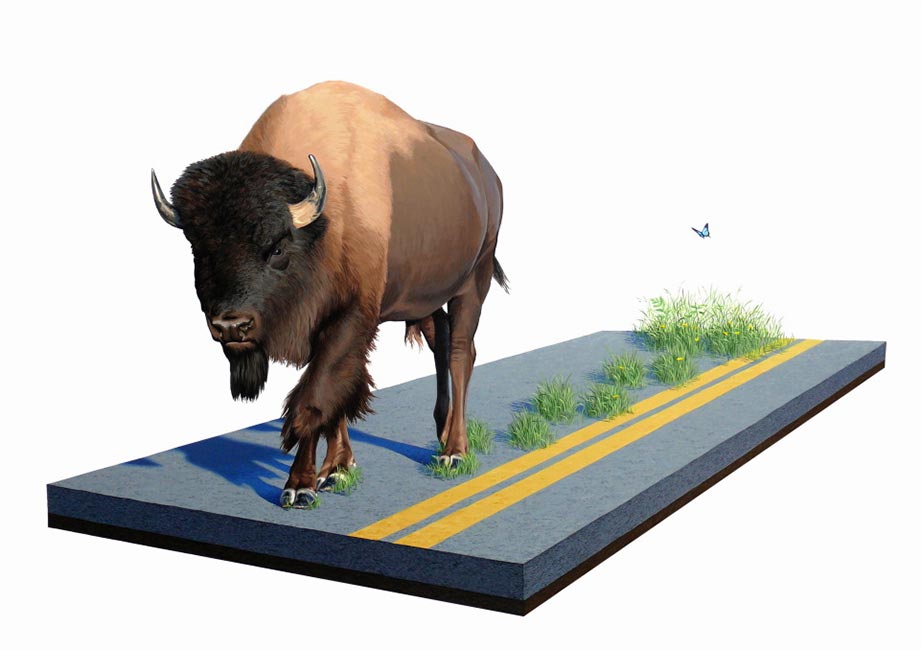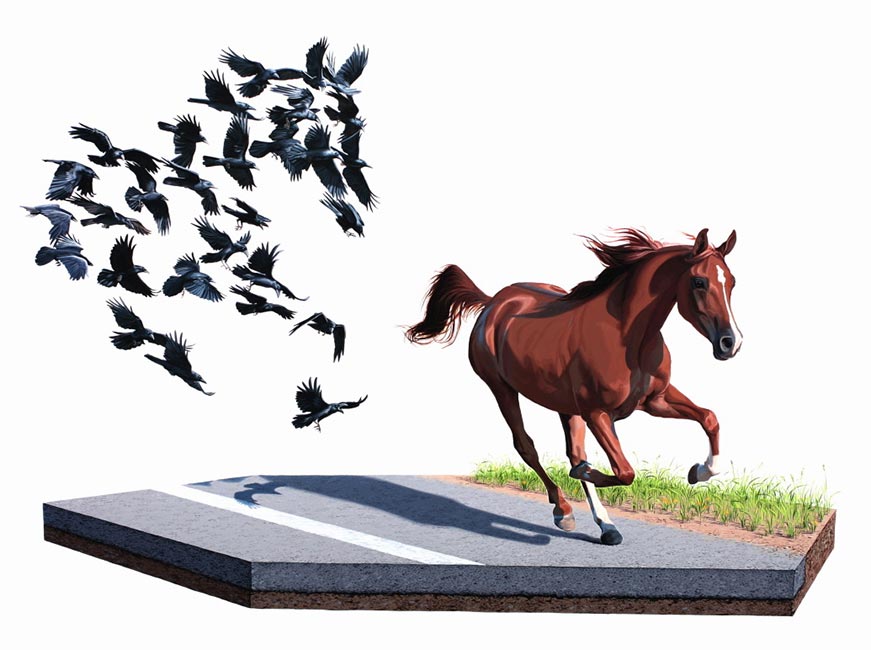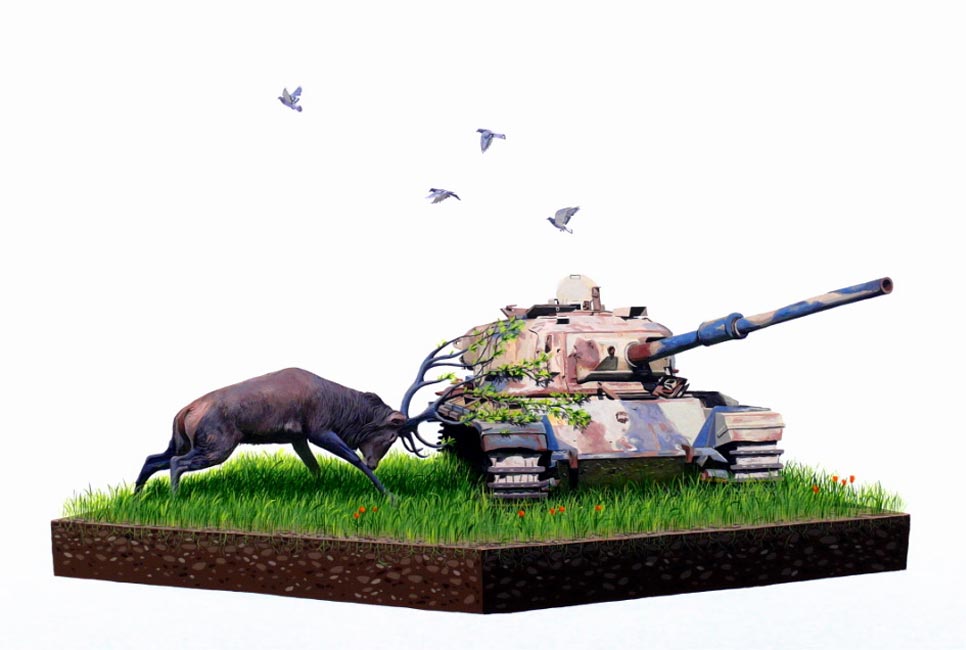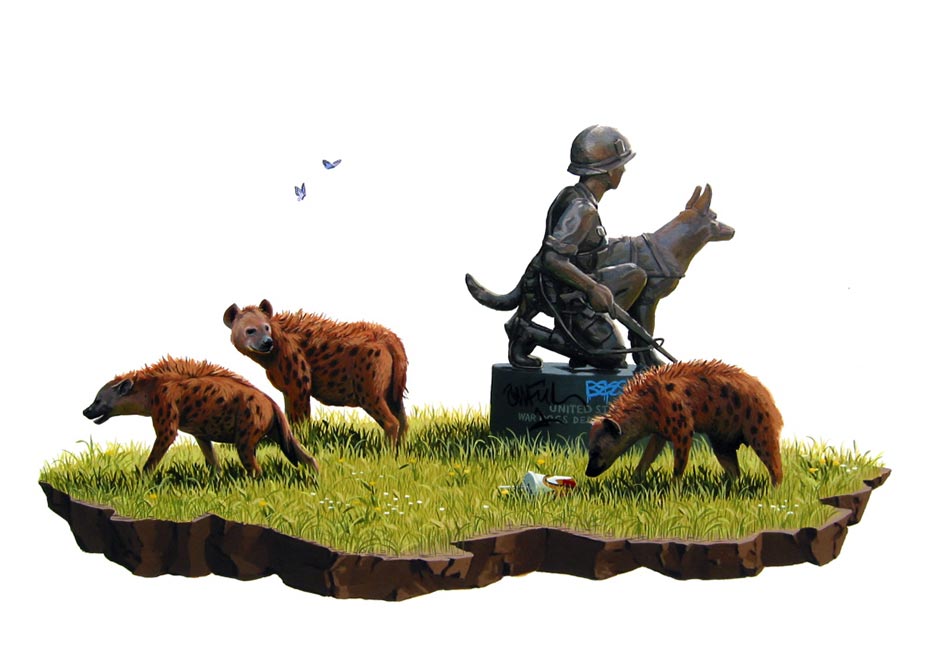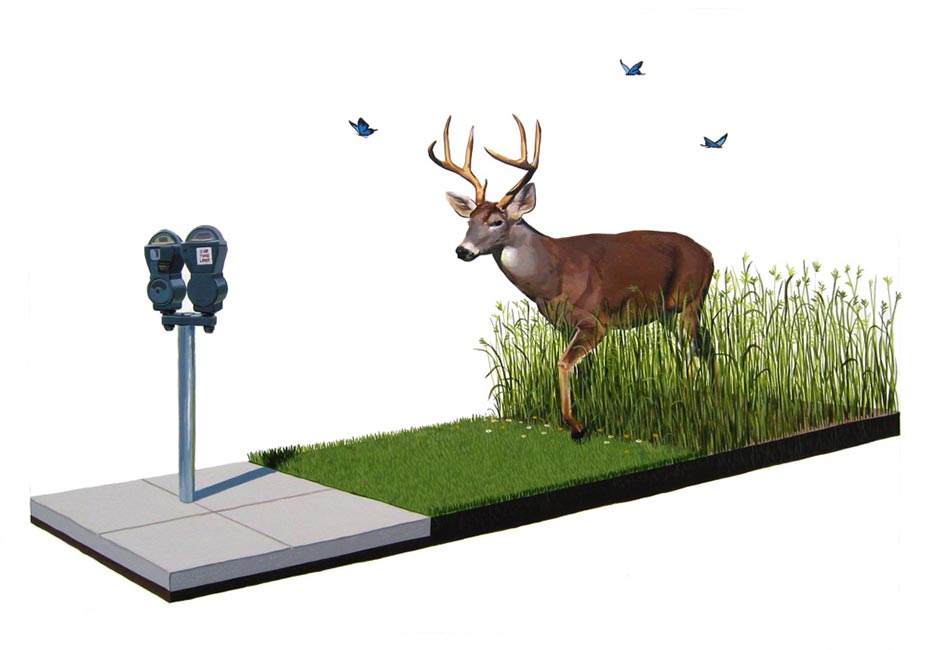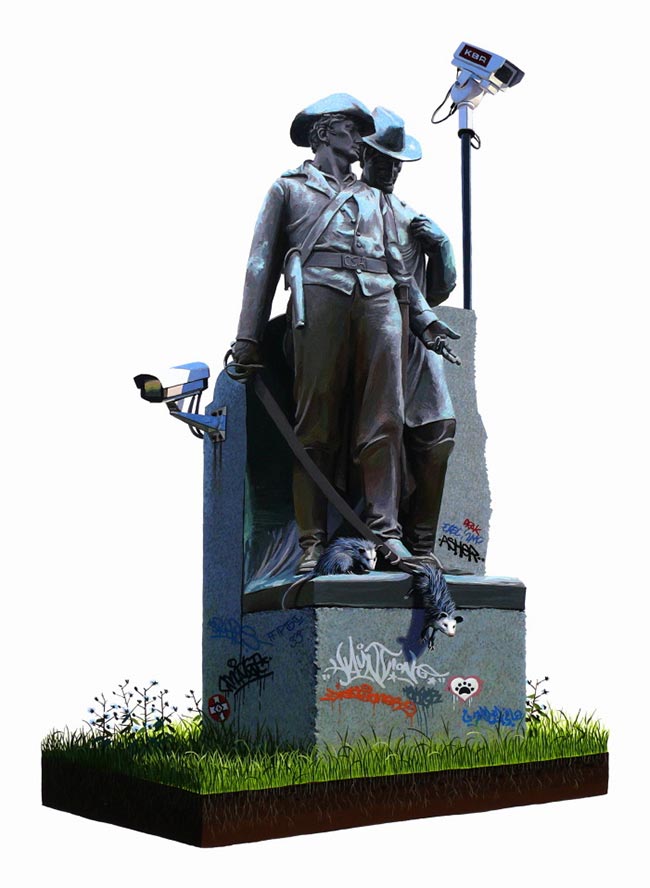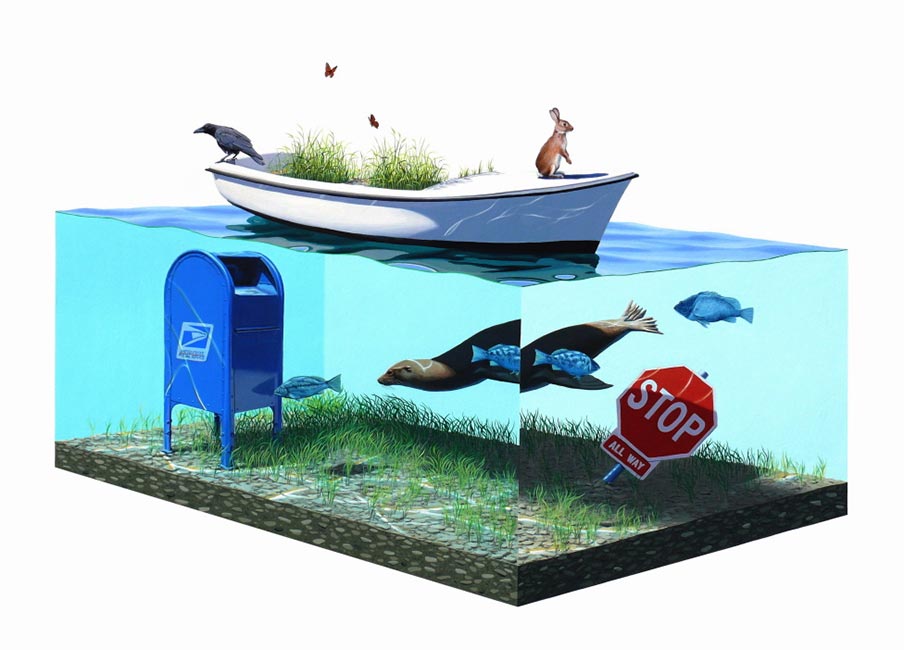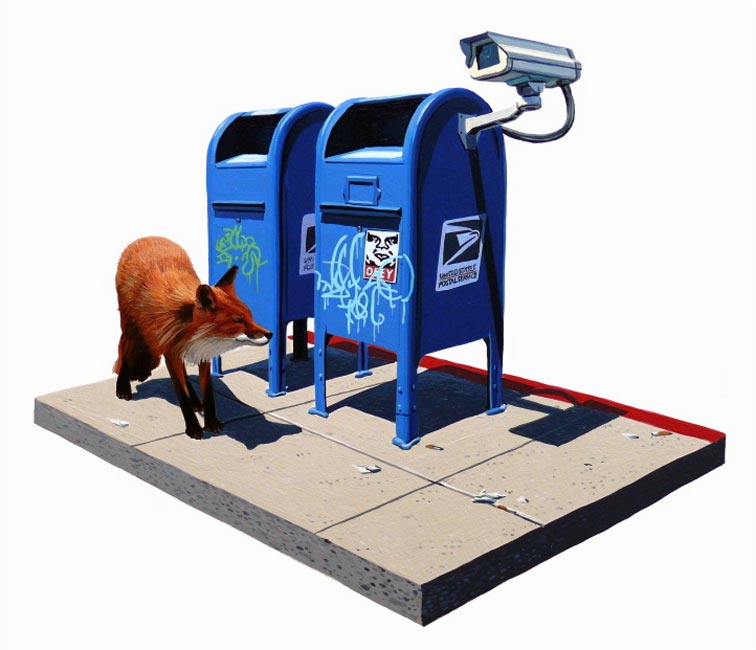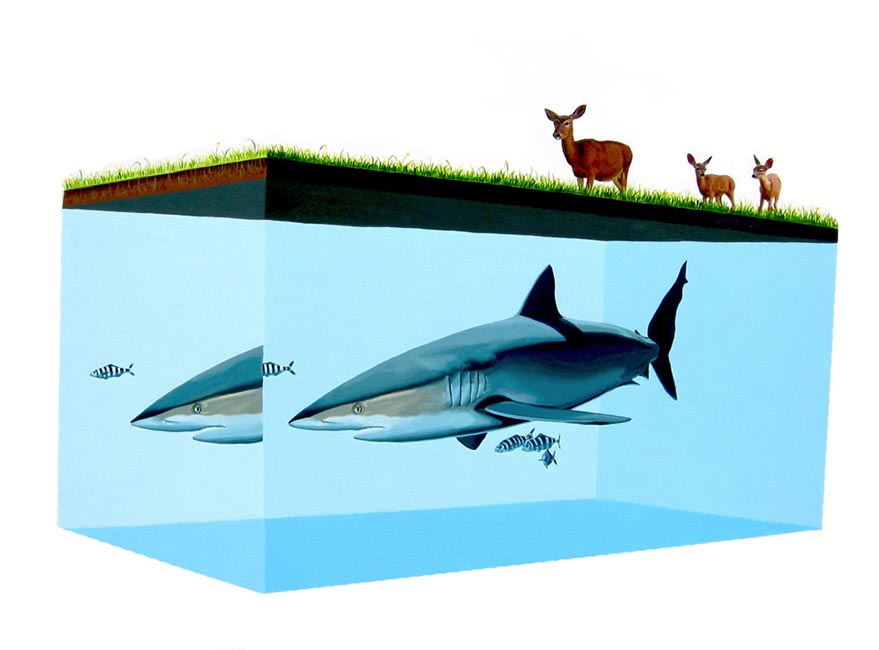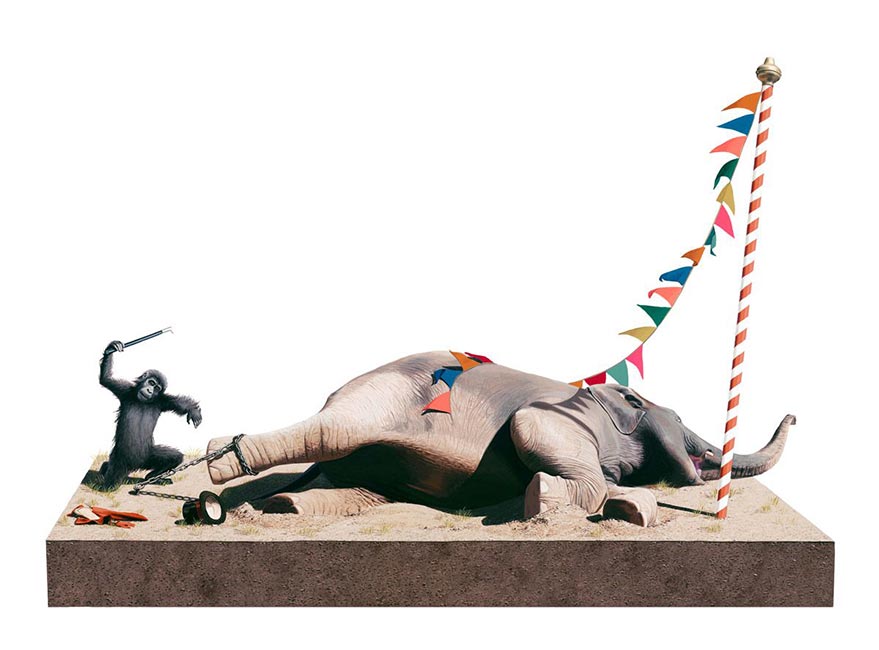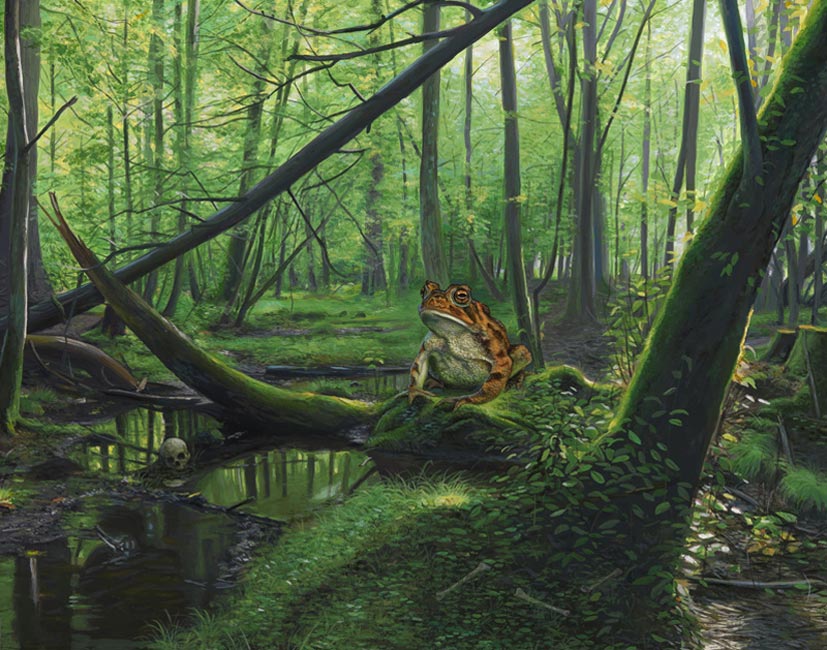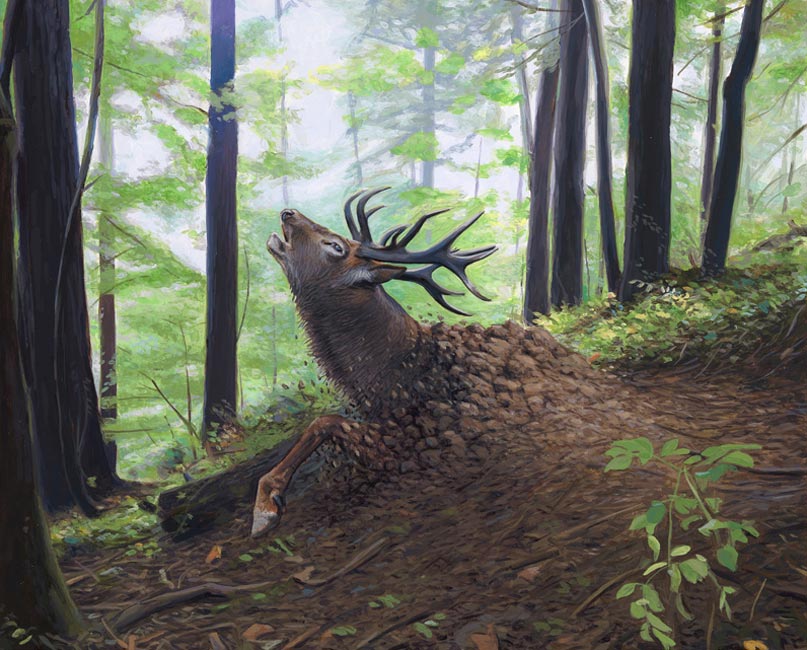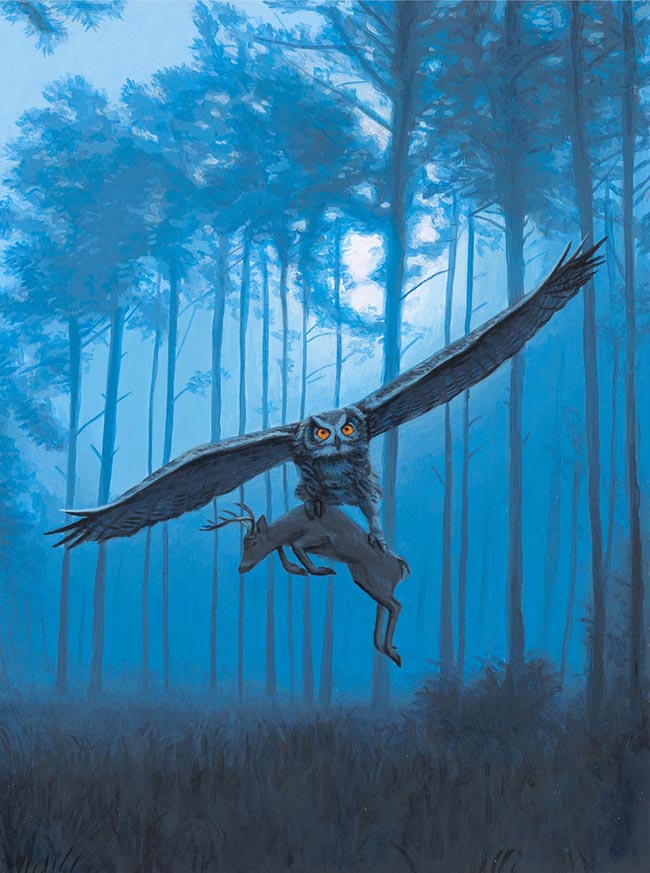Josh Keyes, like so many of us, is deeply concerned by the consequences humanity’s actions are wreaking on our environment and their harmful impact on the Earth and it’s future. Shooting from this standpoint, Keyes composes allegorical dystopian visions which deliver messages geared to provide a wake up call to the masses. Painted with a masterly touch and rendered with compelling realism, Josh’s images produce a tangibility that seriously strengthens the power of his forewarnings. Almost totally devoid of human beings, the world Keyes envisions, is populated by animals forced to evolve and adapt to a new way of life amid the symbolic remnants of humankind’s ultimately thwarted legacy. These fantastical scenarios of displacement come from a profoundly personal locus within Keyes and serve as a representation of his private psychic landscape.
Josh was born in 1969 in Tacoma, Washington and currently live in Portland, Oregon with his wife and artist Lisa Ericson. He received his BFA in 1992 from the School of the Art Institute of Chicago and an MFA in 1998 from Yale University School of Art. His work resides in numerous private and public collections throughout the world.
WOW x WOW had the tremendous pleasure of asking Josh a few probing questions about his working life and artistic musings. Read on to hear what he had to say.
Hi Josh, thanks very much for taking the time to chat, we really appreciate it. If you could start us off by introducing yourself, touching on the formal training you’ve had and what it was that lead you to pursuing a career in the arts?
I grew up in the Pacific Northwest, and was fortunate to have two practicing artists for parents. My father taught and practiced sculpture and ceramics, and my mother taught painting, and created assemblages with found objects. They encouraged me to draw and paint at an early age. I had a strong interest in photorealist painting and science fiction. I spent most of my childhood and teenage years painting and drawing and feeding off of the monthly art magazines my parents subscribed to. I went on to study painting, sculpture, and performance art at the Art Institute of Chicago. Those four years shaped my personal aesthetic and grounded my passion for visual expression and painting. I experimented with many ideas and styles after graduation and four years later decided to go back to school to explore new challenges. I was thrilled to be admitted to the Yale University MFA program where I was thoroughly challenged by the faculty and program. I don’t think I would be making the work I currently am were it not for the rigorous critiques I received from Yale.
Can you remember the first piece of art you ever sold? How did the sale come about and how did it make you feel?
The first piece ended up on our kitchen refrigerator. I think my first real sale was at local arts and crafts fair in Tacoma, Washington. I was into the wacky creatures birthed by Ray Harryhausen’s imagination and created a series of ceramic sculptures of people riding giant slugs. For those that don’t know the slug is Washington States official state bird. There are lots of them, especially after the rain! I suppose my real taste of financial success and the impulse and confidence that I could make paintings for a living was the result of a show I had at a gallery in San Francisco, and every painting sold prior to the opening. That was about 15 years ago, and I still recall the overwhelming feeling of both awe struck, and gratitude.
Your paintings are generally void of humans, they are however, very much about the human race and the destructive impact we’ve had on our environment. Can you discuss your current thoughts on this matter and some of the issues you have been tackling in recent works?
Some of the issues I explored early on have become quite commonplace in the daily news headlines. Global warming, climate change, species and ecosystem displacement, rising sea levels, and the impact of the human population were some of the themes I incorporated into the imagery. My visions were often loaded with a dystopian extremism, a life without people, or after earth tone. I think it’s obvious by now that human civilization, has had and continues to have an effect on the earth and its complex and fragile biosphere. At this point I think a certain amount of damage has been done, and though we may not see the effects I think future generations will encounter these changes and challenges, perhaps even in our children’s lives. I am not resting in apathy but in many ways we as a species have crossed the tipping point. The environmentally conscious industrial and consumer habits and processes are in a process of change. If we do not end up blowing up each other and all life on earth, I think over time we can establish a living balance with the earth, and respect for our differences and cultures. I truly hope that is the direction we are moving in.
Recently a number of your paintings have moved on from your signature white backgrounds and the isolation they gave your scenes of drama. You have opted instead to fill the entire pictorial field with your beautifully rendered narratives. What lead you to making this change and have you ever felt any pressure to continue painting in the style that you have become know for?
When you make something over time, in my case over 15 years, sometimes like a plant or tree a new branch has the desire to grow. It comes from the same origin, but it might find a new space and sunlight to explore. And grow. I really enjoy the classic white background, and will continue working with it. The new space opens up new ideas and a new challenge for developing and building on the existing narrative and themes. I like to think of both styles existing in some kind of dystopian museum. The white paintings are like specimens, carefully arranged for display, the new work reads like dioramas you might see in a natural history museum. Both explore the subject matter from a different point of view. One is diagrammatic and objective, and the other is immersive. I am excited to see where the new work takes me, and to see how it will inform the earlier style.
As you’ve mentioned, there is a prevalent dystopian theme running through your work. What would you say have been the biggest influences on this area of your art?
I grew up on sci-fi movies and novels as a kid and have continued to explore this theme. I suppose my first exposure was with the film Wizards by Ralph Bakshi. Followed by Mad Max, Road Warrior, Escape from New York, A Boy and His Dog and after that I watched anything falling into the dystopian trope. H.G. Wells, Aldous Huxley, and Jules Verne were great sources for what the world might be like in a future gone wrong. Nowadays the screens and bookstores are full of dystopian stories. Two contemporary favorites are Margaret Attwood’s Oryx and Crake and The Dog Stars by Peter Heller. My feeling is that the culture is catching up to the idea that things might not be so great in the not too distant future. I suppose that is why there is also a fascination with zombie culture. We seem to be developing a new mythology of impending loss, grieving and how to cope with what remains. How to sustain hope, in a landscape or world of hopelessness. Much of this seems to be psychological. Though we may indeed see physical changes in the environment, currently the wasteland appears to be online and what we digest and regurgitate culturally as an online global entity and consciousness. Though ‘connected’ more tightly than ever before, with exception to some religious societies and cultures, many people admit to feeling isolated, alone, and that the experience of online activity has opened a void in their psyche. I think we are still new and young in terms of the amount of information we can process and use in a healthy and productive way. I have a feeling evolution is not quite finished with us, and our technology is shaping us, or our consciousness, be it positive or negative, time will tell.
A question we often ask artists during our interviews deals with intentionality and whether or not the artist feels it is important for an audience to understand his or her intention when creating the art. Judging by the nature of the messages you want to convey through your work, we can only assume that you really hope for viewers to ‘get’ your intention. Can you share some of your thoughts about this side of your practice and how transparent you want the meanings to be?
I would say much of my early work is ‘loaded’ with specific content and a message. Often this was an environmental point of view or political statement. Over time I have wanted to bring the work to a personal point of expression. Embracing fantastic and more dreamlike or surreal imagery. There are still echo’s of the soap box, an overgrown mailbox, or fire hydrant. For me when the work is too literal it sometimes closes into one statement, it can’t really expand or go from there. Not that that’s a bad thing, that is one of the most powerful elements of visual art and communication. I suppose for me, turning 45 and having a new daughter, a new chapter of life has opened for me. I am still the outraged punker, but am taking a break from the riots and demonstrations to experience and connect with an older story, a philosophical and metaphysical space.
You currently have a painting in the landmark ’20 Years Under the Influence of Juxtapoz‘ exhibition (the show, which has been co-curated by Andrew Hosner of Thinkspace Gallery and Gary Pressman of Copro Gallery, is being held at Los Angeles Municipal Art Gallery). Can you tell us what being a part of this show means to you, what kind of influence Juxtapoz magazine has had on you personally and what your thoughts are about the New Contemporary Art scene?
I am so thrilled to be part of this amazing show! What an honor. I had a really hard time at Yale. Most of my ideas and paintings were shot down and I don’t think my voice was heard. Or if heard there was an attempt to silence it with what I felt to be old, tired, formalist dogma and practice. After graduation, I moved out west to California and found kinship with Juxtapoz and Fecal Face, an art and culture website founded and created by John Tripp. I began to trust my instincts again, and to paint and explore imagery that I was passionate about, no matter what my Yale colleagues and faculty might think. The culture and philosophy of Juxtapoz embraces the eccentric, the outsider qualities and sheds light on these individuals and movements and gives them voice. Prior to the explosion of the internet, the art world was a closed entity. Juxtapoz and other publications and websites have transformed and opened the art world for both collector and artist.
Why do you think that painting is still managing to stay relevant, irrespective of many critics and academicians proclaiming it’s death over the years?
There is nothing like seeing a beautifully crafted object. I don’t think I am a master painter, I still have much to learn, but when you see a striking painting, no matter the style or technique, there is I believe a lasting or presence. A hand made this, a flick of the fingers and there is a refection, made with soul, dipped in colored mud.
In order to get a better understanding of the personality of an artist, it can help to get a peek behind the curtain. Would you be willing to share a story from your own life, one which you feel has contributed to shaping the person and therefore the artist you are today?
To the core I love making art. It’s more than just a profession. I was once told by a professor that I would be considered an outsider artist if it wasn’t for my knowledge of art history. I was diagnosed with bipolar, or in my day we called it manic depression some years ago, my work is also my therapy. It is my medicine. It comments on the state of the world and environment, and is also autobiographical. Certain animals and forms stand and symbolize personal thoughts and emotions. There are personal keys and elements that signify moments in my life, there is a private and personal thread that runs through my entire body of work. Like a map of the soul, I can look at certain paintings and decode a mood or record of a dream I had. Like the metaphysical artists from the early 1900’s my paintings represent a state of mind, a psychic space.
You mentioned your knowledge of art history and it’s relationship to outsider art. Are you of the opinion that as an artist it is important to have a solid understanding of what has gone before you? Do you feel art can still be relevant if it is not informed in this way?
I don’t think it is important, but to this professor, in his opinion, an artist with knowledge of art history and one’s position or place in it, is different from a person who creates out of an eccentric or obsessive need. The work is made regardless of audience or art market, or status, it is necessity. Though sometimes crude and raw there is a honesty and emotional charge that is devoid of art-historical rhetoric or self consciousness of ‘this is art’, it’s the stuff of the soul. I personally think some of the best art I have seen has been created by people who never attended art school. Having a knowledge of art history is useful but sometimes it can be a burden, and knowing too much can cause true instinct and one’s personal voice to quiet down. I have met a few artists who gave up art because “everything had been done” why bother. I don’t agree with that, making art, writing, dance, it is a continuous dialog, a conversation with the past and forging ahead into the unknown.
What would you say has been the biggest challenge for you since you’ve become a professional artist?
I think the balance between my personal life and professional life has been challenging. Working is great and having a demand for the work is wonderful, but to sacrifice your social or personal life can be dangerous. Because the work comes from life, from your experiences, it is important to live one’s life to create space for your dreams and introspection, and most important to play. I have met some grumpy old and young artists who sacrificed much for success and fame. Though they “had it all” they did not seem happy to me.
What’s next for Josh Keyes?
As a new dad I am thrilled to be a part of my daughter’s life. I can’t say enough about the massive emotional transformation of becoming a parent, and also how it skyrockets your relationship with your wife. The world changes instantly. Love, horror, anxiety, euphoria, like geysers erupting periodically from your heart. Aside from being a new dad and parent I have a number of shows planned for the future and I am really excited to see where the new imagery will take me. It’s like getting onto a ship and letting the wind and waves carry you off. Let’s go!
